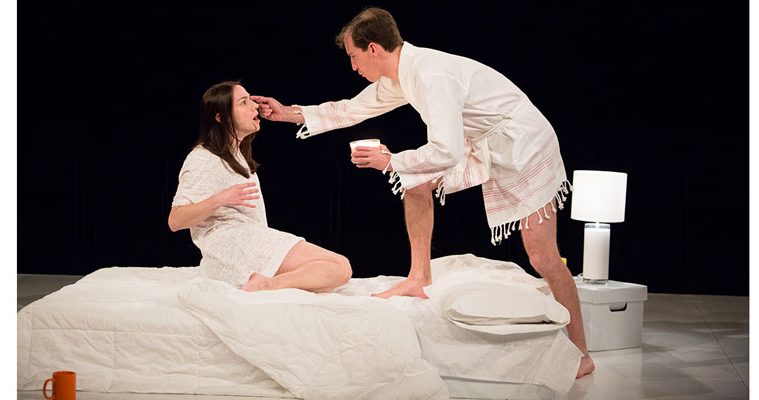
In Tom Stoppard’s 1972 play Jumpers, a character asks, “What’s so good about Good?” Mentioning this line in a note on his new play, The Hard Problem, Stoppard writes “I haven’t gotten any further.”
The question remains the same, but, as Stoppard has noted, who asks it has changed drastically in the interim. In 1972 the question, if it came up, was the province of moral philosophers. In 2015, a book was published with the title Does Altruism Exist? As Stoppard remarks, this title “would have once interested mostly people interested in ethics and moral philosophy, but now the book will be picked up more by people interested in biology, zoology and altruism as an observable fact in nature.”
For The Hard Problem, Stoppard’s characters are no longer tweedy (if acrobatic) Oxbridge dons, but trendy scientists of both the hard and soft variety who work either at a prestigious Institute for Brain Science, trying to discover the secret of consciousness, or at a hedge fund that supports the Institute – the skill set seems basically interchangeable.
The Hard Problem centers on Hilary, whom we meet as a 22-year-old psychology student applying for a coveted position with the Krohl Institute for Brain Science. She gets the job, and becomes a top researcher there. But she finds herself at intellectual odds with Spike, her former tutor and sometimes lover, and her colleagues: they believe that the brain and the mind are identical. In their view, emotions such as maternal love and altruism are simply nice names for “maximizing gene survival” – an idea popularized by books such as Richard Dawkins’ The Selfish Gene – and that a thermostat might be on the verge of consciousness if its circuitry became complex enough. Hilary believes, in Stoppard’s words, “that goodness has an objective reality that is not captured by, explained by, defined by, evolutionary science, evopsychology, evobiology, or neo-Darwinism.”
Stoppard draws upon a wide range of brain research, game theory, and philosophical speculation in The Hard Problem, which takes its title from philosopher David Chalmers’ name for the question of consciousness itself. “We know consciousness far more intimately than we know the rest of the world,” Chalmers writes, “but we understand the rest of the world far better than we understand consciousness.” Stoppard takes it further with, “There’s a moment of discontinuity where form – brain activity – becomes content, and that is our mystery, it’s what makes us human.” He continues, “Human beings are of course animals, but are we just very very sophisticated animals or does being human mean something beyond biology, and if it seems to, is that something only our illusion, our conceit?” The question becomes stronger when “good” and “bad” enter the equation: “Why is the comparison between the two in order,” Stoppard asks. “Why are we even bothering to label things as good and bad? Where’s that coming from?”
Wilma Theater Artistic Director Blanka Zizka – and director for The Hard Problem – has known Stoppard for decades. The Hard Problem is the twelfth Stoppard play produced at the Wilma, and the fifth Zizka has directed. She was drawn to the play because “the lives of the characters are shaped by their specific understanding of and belief in what meaning, life, and existence are. The energy of the play is born out of deep persuasions formulated into vivid verbal expression; the language is precise and can be treated almost musically. For that reason, I have stripped the production to the bare minimum so that nothing prevents us from hearing the complex thoughts.”
To amplify the musicality of the play, she’s also added a live saxophonist to the production with Stoppard’s approval. “Early in the play we learn that when Hilary was only fifteen years old, she gave birth to a girl and gave her up for adoption. I think about this decision as a moment of time that has been frozen and become what Hilary carries with her, always. I wanted to give voice to this frozen time: the musician becomes Hilary’s observer, inner voice, sorrow, and hope – her consciousness.”
In 1868, John Tyndall, who discovered greenhouse gases and why the sky is blue, wrote: “Let the consciousness for love, for example, be associated with a right-handed spiral motion of the molecules of the brain, and the consciousness of hate with a left-handed motion. We should then know, when we love, that the motion is in one direction, and when we hate, that the motion in in the other; but the ‘WHY?’ would remain as unanswerable as before.” Tom Stoppard invites us to consider if “WHY?” is any more answerable now than it was 150 years ago.
The Hard Problem plays at The Wilma Theater through February 6, 2016. Click here for tickets.

Noël Coward’s Travels

Kate Chopin in New Orleans: Mother-Daughter Author Duo Collaborate on Historical Book

